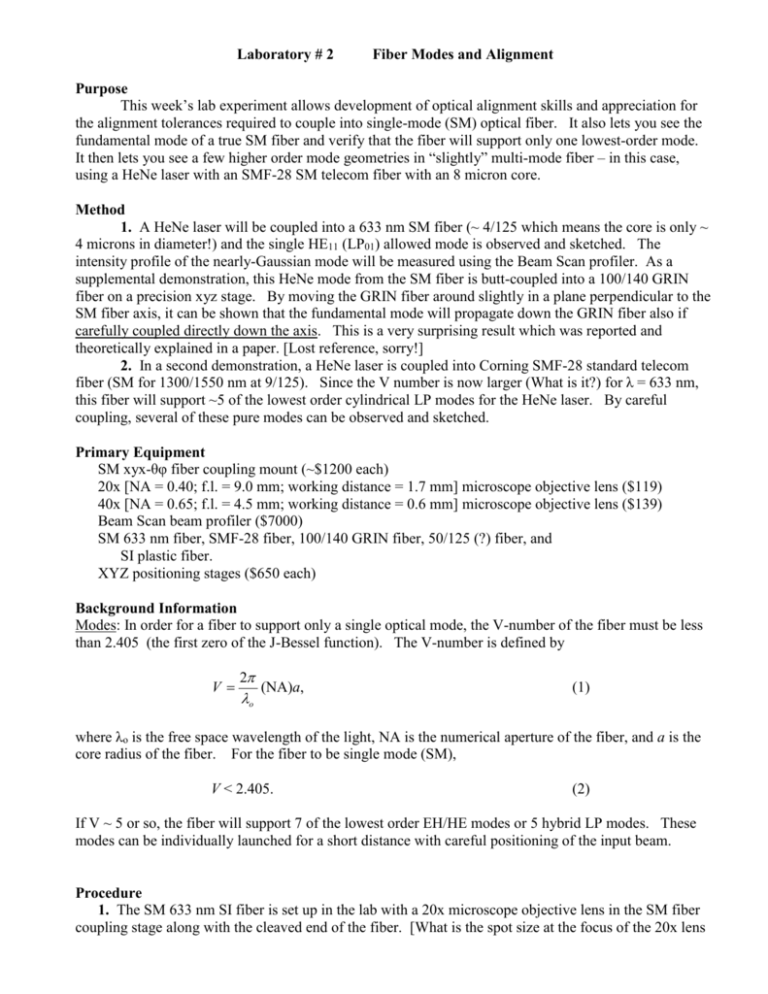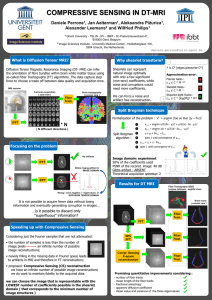Laboratory #2
advertisement

Laboratory # 2 Fiber Modes and Alignment Purpose This week’s lab experiment allows development of optical alignment skills and appreciation for the alignment tolerances required to couple into single-mode (SM) optical fiber. It also lets you see the fundamental mode of a true SM fiber and verify that the fiber will support only one lowest-order mode. It then lets you see a few higher order mode geometries in “slightly” multi-mode fiber – in this case, using a HeNe laser with an SMF-28 SM telecom fiber with an 8 micron core. Method 1. A HeNe laser will be coupled into a 633 nm SM fiber (~ 4/125 which means the core is only ~ 4 microns in diameter!) and the single HE11 (LP01) allowed mode is observed and sketched. The intensity profile of the nearly-Gaussian mode will be measured using the Beam Scan profiler. As a supplemental demonstration, this HeNe mode from the SM fiber is butt-coupled into a 100/140 GRIN fiber on a precision xyz stage. By moving the GRIN fiber around slightly in a plane perpendicular to the SM fiber axis, it can be shown that the fundamental mode will propagate down the GRIN fiber also if carefully coupled directly down the axis. This is a very surprising result which was reported and theoretically explained in a paper. [Lost reference, sorry!] 2. In a second demonstration, a HeNe laser is coupled into Corning SMF-28 standard telecom fiber (SM for 1300/1550 nm at 9/125). Since the V number is now larger (What is it?) for λ = 633 nm, this fiber will support ~5 of the lowest order cylindrical LP modes for the HeNe laser. By careful coupling, several of these pure modes can be observed and sketched. Primary Equipment SM xyx-θφ fiber coupling mount (~$1200 each) 20x [NA = 0.40; f.l. = 9.0 mm; working distance = 1.7 mm] microscope objective lens ($119) 40x [NA = 0.65; f.l. = 4.5 mm; working distance = 0.6 mm] microscope objective lens ($139) Beam Scan beam profiler ($7000) SM 633 nm fiber, SMF-28 fiber, 100/140 GRIN fiber, 50/125 (?) fiber, and SI plastic fiber. XYZ positioning stages ($650 each) Background Information Modes: In order for a fiber to support only a single optical mode, the V-number of the fiber must be less than 2.405 (the first zero of the J-Bessel function). The V-number is defined by V 2 o (NA)a, (1) where λo is the free space wavelength of the light, NA is the numerical aperture of the fiber, and a is the core radius of the fiber. For the fiber to be single mode (SM), V < 2.405. (2) If V ~ 5 or so, the fiber will support 7 of the lowest order EH/HE modes or 5 hybrid LP modes. These modes can be individually launched for a short distance with careful positioning of the input beam. Procedure 1. The SM 633 nm SI fiber is set up in the lab with a 20x microscope objective lens in the SM fiber coupling stage along with the cleaved end of the fiber. [What is the spot size at the focus of the 20x lens Page 2 and where is it located?] Turn on the HeNe laser (if it is not on) and couple the laser into the 4 μm diameter core of the fiber. This will require careful adjustment of the xyzθφ controls. Let the light from the far end of the fiber expand onto a sheet of white paper and observe the HE11 (or LP01) mode allowed in the fiber. Try changing the input coupling and note any changes in the output. When you have a bright LP01 mode, use the Beam Scan profiler to measure the spot intensity vs. radius to see that it is very nearly Gaussian. [Turn on the Beam Scan (switch in the back). The front panel will light up and the slit wheel will rotate in front of the detector in the head. Position the head so the beam is shining into the opening in the front and is much smaller than the opening. Connect the “signal out” BNC connector on the front panel to an oscilloscope and observe the pulse shape. The signal is the optical intensity integrated over the slit as it passes through the beam. Sketch the shape of the pulse you observe. If you are energetic, you could do a log plot of the intensity vs. radius and show that it fits a Gaussian pretty well. Finally, there is a length of 100/140 GRIN MM fiber on the same table. Using the xyz stage, position one cleaved end of this fiber directly in front of the end of the 633 SM fiber and try coupling the output into the lowest order mode of the GRIN fiber. You should carefully position the two fiber ends concentrically and then gently bring them together until they are touching. You can try mis-positioning the 100/140 fiber off axis and see how the modes change. Sketch the low order mode you see. 2. The SMF 28 SI telecom fiber (single mode for 1300/1550 nm lasers) is set up on another table in the lab with a 40x microscope objective lens in the SM fiber coupling stage along with the cleaved end of the fiber. [What is the spot size at the focus of the 40x lens and where is it located?] Turn on the HeNe laser (if it is not on) and couple the laser into the 9 μm diameter core of this fiber. This will require careful adjustment of the xyzθφ controls. Let the light from the far end of the fiber expand onto a sheet of white paper and observe the HE11 (or LP01) mode allowed in the fiber. Try changing the input coupling to observe several of the modes supported by this fiber at 633 nm. Sketch the modes you are able to find. [Note: To get from the LP01 mode to the LP02 mode, move the fiber closer or farther away from the lens but on the same axis.] Answer the following questions in addition to your mode sketches and plots of n(r): 1. What is the calculated spot size for the HeNe laser at the focus of the 20x lens and where is it located? For the 40x lens? How does this depend on the input beam diameter? 2. Use equations (3) and (4) and the definition of Δ to derive equation (6). 3. What is one advantage GRIN fibers have over SI fibers? (Check in your book) 4. What is one advantage SI fibers have over GRIN fibers? (Check in your book) 5. In words, describe what a “mode” in a fiber is. 6. Sketch and describe in words or a graph of intensity vs. radius, the lowest order LP01 mode from the SM 633 nm fiber. 7. Sketch (and try to identify by comparison to the modes in your notes) the higher order modes you were able to excite in the SMF-28 fiber with the HeNe laser.







